Junkers Ju86
see also: Junkers Ju86 Production List / Junkers Ju86 Survivor List / Junkers Ju86 Philatelic Items / Junkers Ju86 Model Kits
passenger airliner and bomber aircraft, F/F: 04. November 1934
cantilever monoplane in smooth metal construction by Ernst Zindel
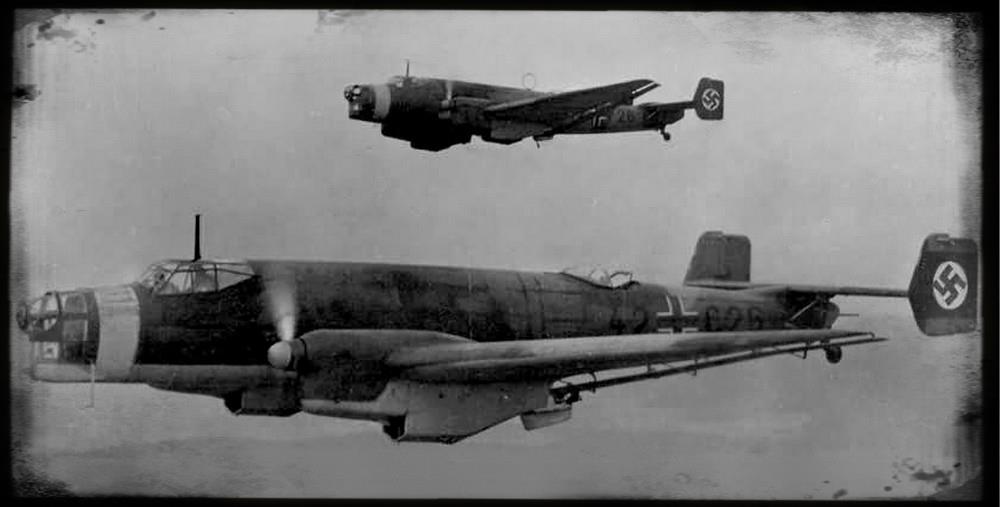
Junkers Ju86-A Bomber Aircraft
As soon as Hugo Junkers was replaced from his company, the Reichsluftfahrtministerium (RLM) placed an order for the developement of a twin engined bomber aircraft in the end of 1933. An alternate developement request was also placed at Heinkel Flugzeugwerke by RLM, which started the Heinkel He111 developement due to this request. Later a third request was given to Dornier, from which the more improved Dornier Do 17 arised. At the same time, Lufthansa was looking for a modern quick passenger aircraft with two engines as an addition to the single engined He70 Blitz aircraft. Therefore the RLM combined military and civil demands for the new aircraft.
Zindel started the developement of the Ju 86 in early 1934. Zindel had already twin engine experiences from the S36 and K37 designs. On request of Koppenberg the Jumo 205 engines were used for the Ju86. In April 1934 a mockup of the bomber version was available and on November, 4th 1934 the Ju86 prototype (c/n 4901) was flown first. This prototype was also a military version of the Ju86. As the Jumo 205 is still under developement at the time of the first flight of the Ju86, the prototype was equipped with Siemens SAM22 engines.
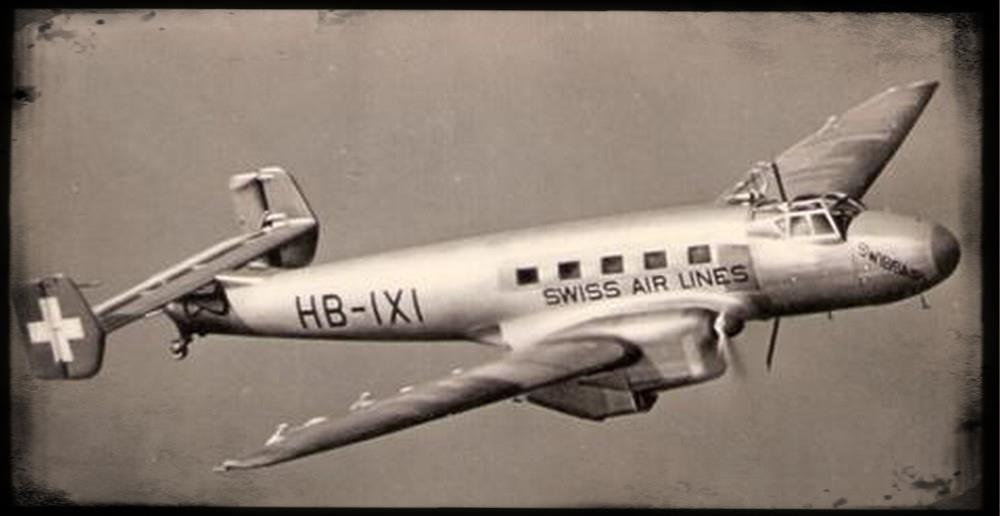
Junkers Ju86-C Civil Airliner
On March 22nd 1935 the second prototype (c/n 4902) was ready for its first flight. This second prototype was the civil passenger airliner version of the Ju86 and it was already equipped with the Jumo 205 at the time of its first flight. A further two prototypes, one military and one civil were built during 1935. During the flight test programme the need for a redesign of the wings was discovered as the Ju86 was not stabilized enough The fifth prototype therefore got a new wing design. This aircraft was the first aircraft of the preproduction series. The V5 was used for RLM trials and it achieved the type approval for the military Ju86-A0 versions in March 1936. In 1936 the RLM ordered a preseries of seven Ju86-A0, which were used for military service tests at the KG152 between May and November 1936.
The initial main production line Ju86-A1 was started in spring 1936. The front nose section was modified with the socalled Vela-Kanzel instead of the glazed nose panels. When the A1 was used more intensively, further problems arised from the horizontal stability of the aircraft. Therefore the fuselage was extended and the tank volume was increased. This modified version was designated as Ju86-D1. Some D1 were later used in Spain by Legion Condor.
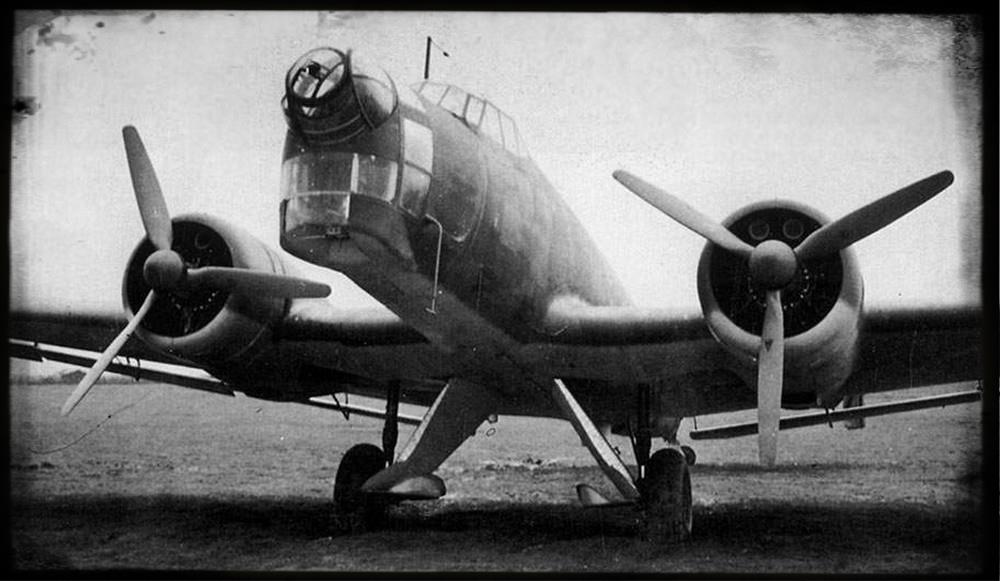
Junkers Ju86-E with BMW 132F engines
Other major problems of the Ju86 were caused by the Jumo 205 engines. Already in 1936 it became obvious, that oil engines were not suitable for missions, where the engine power was changed quiet often, i.e. squadron flights. Therefore the reliability of the Luftwaffe Ju86 showed a bad performance due to the high number of engine changes. In September 1936 initial trials were started with a BMW132F piston engine on the Ju86. The introduction of this piston engine increased the military Ju86 reliability and all Ju86-A1 and -D1s were converted to the new Ju86-E1 standard with BMW132F engines. Nevertheless, the introduction of the piston engine required 60% more fuel weight than the Diesel engine needed. Therefore the Ju86-E1 got an increased tank of 1500 litres. The civil Ju86s kept the Diesel engines due to the different operational profile with long flights and constant power requirements.
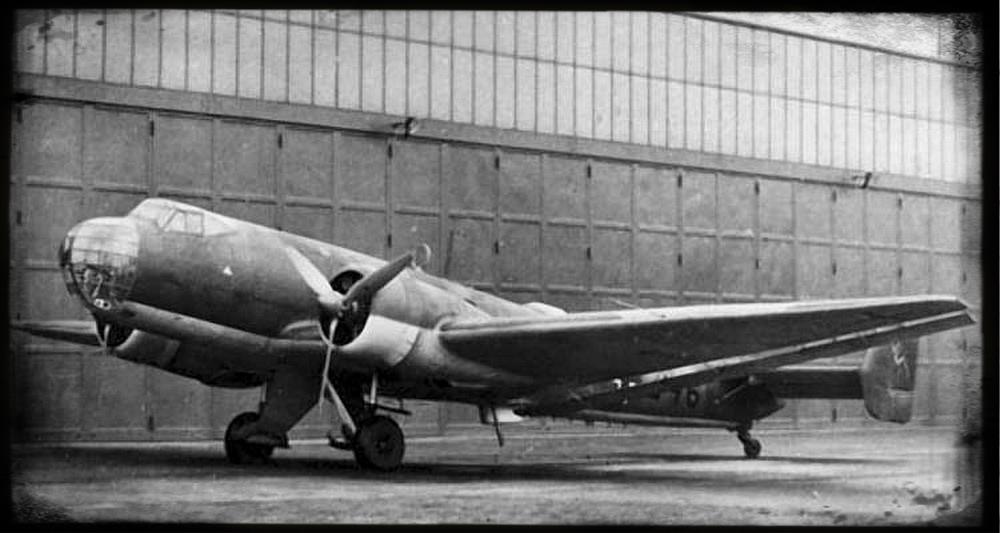
Junkers Ju86-G
In 1937 another operational problem of the Ju86 was fixed. While the Ju86 was moving on the ground the pilot had no opportunity to see, what is in front of the aircraft. Therefore the Vela-Kanzel was removed and the complete front section was glazed. In summer 1938 the first of these new Ju86-G1 were delivered. In April 1939 the last Ju86 was delivered and the production came to an end.
In 1938 the RLM had ordered several high altitude bomber aircraft from Dornier Do217P and from Henschel the HS130E. When the Ju86 production came to an end, the Junkers Flugzeugwerke tried to modify this design for high altitude missions. Junkers had already gained experiences with high altitude aircraft during the design of the Junkers EF61 and the Junkers Ju49. Also the Jumo 205 engine was modified to an high altitude engine after it had been removed from the serial production lines of the Ju86. The RLM was interested in the Ju86H proposal and ordered a total of 40 high altitude bombers from Junkers in September 1939. Under the designator Ju86P three prototypes were built.
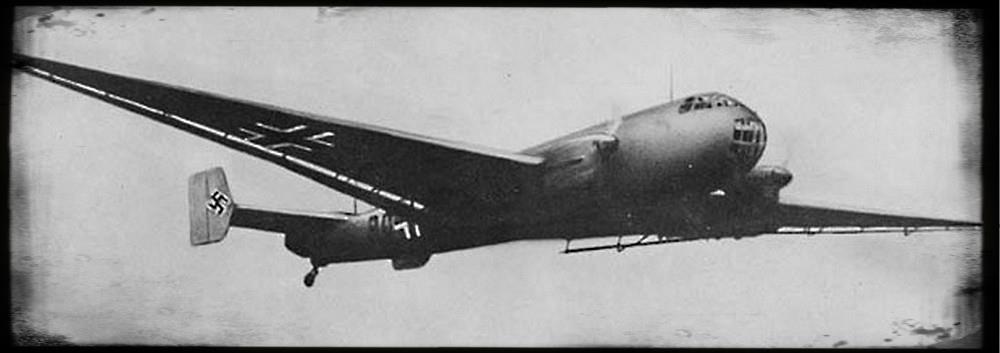
Junkers Ju86-R High Altitude Aircraft
These prototypes were original Ju86G1 with a complete new nose section, which included the pressured cockpit for two people. Instead of the BMW132 piston engine the further developed Jumo 207 was used as a high altitude engine. The first flights were performed at the end of 1939. During the flight tests the wing span was increased to climb to altitudes above 10000 metres. The Ju86 joint the operational units of Luftwaffe during 1940/41 and was mostly used for survey missions. It took two years, before the first Ju86P2 was shot down by an Allied aircraft in August 1942. Since then the Ju86Ps were equipped with machine guns for self-protection.
Further improvements were made on the Ju86P to increase the maximum altitude. The Ju86R again got an increased wing span and new propellers with enlarged blades. The Ju86R now was able to climb up to 14000 metres. It became available in late 1942 and was mainly used for survey missions. The Ju86R3 was projected with the new Jumo 208 and was calculated for a maximum altitude of 16000 metres. But due to engine developement problems this version was not finished.
The Ju 186 developement was started during 1942 and was based on the Ju86R. As the Jumo 208 was not available, the Ju86R was redesigned for four Jumo 207C engines. Initial calculations made obvious, that the reachable altitude was limited to 13000 metres and the project was stopped by RLM in 1942. The Ju 286 was a parallel six engine design, which also did not came into prototype stage.
While the original Ju86 production was ceased already in 1939, the conversion of former Ju86Gs into high altitude aircraft lastet until 1942/43, when the military developement of the Ju86 was finally stopped. The military Ju86 were not only produced for Luftwaffe. Some of them were also sold to foreign airforces. It seems as Junkers had offered the Ju86 already in 1933 to Sweden under the designator K85 as a seaplane. Later export versions were designated as Ju86K. Initial aircraft were ordered by Sweden and Hungaria in 1936, Chile and Portugal placed orders in 1937 and three Ju86Ks were sold to Austria, but not delivered until 1938. The largest fleet of Ju86Ks outside Germany was operated by Hungaria, which bought 66 aircraft. The engines for these aircraft were built in Hungaria under license. Sweden ordered a total of 25 Ju86K. Twenty of these aircraft were built under license in Sweden as Saab B3 by Saab and Nohab. These Swedish Ju86Ks remained in service until the mid 50s.
The civil Ju86 was designed for 10 passengers plus a crew of three. After the first flight of the second civil prototype (V4), this aircraft is handed over to Lufthansa in September 1935 and is used for operational tests. The first six Ju86B1 were delivered to Lufthansa during 1936 plus a further six Ju86C1 in 1937. Including two prototype aircraft Lufthansa operated a total of 12 Ju86 aircraft until 1940, when these aircraft were handed over to Luftwaffe. Like the military Ju86, also the civil Ju86 showed instabilities on its horizontal axles. Therefore the same fuselage modifications were performed on the Ju86B as on the military Ju86A. The Ju86 with extended fuselage was designated as Ju86C1. This type as also equipped with the modernized Jumo 205-C3.
Following two longrange record flights of the civil Ju86 airlines outside Germany became also interested in this aircraft. The civil export versions were designated as Ju86Z. Two Ju86Z1 were delivered to Swissair in 1937 with Jumo 205C. Due to the engine problems these were later converted to BMW132 engines. A further four Ju86Z1 were sold to LAN Chile in 1938. These were equipped with Hornet engines. A total of 20 Ju86Z2 were sold to Manchuria in 1938 for the Manchurian Aviation Company. Until breakout of WWII 17 aircraft had been delivered and registered M210 to M214. Further 17 Ju86Z5 were delivered to South African Airways between 1937 and 1939. These aircraft initially were equipped with the Hornet SIE-G and were later converted to Krestel and Hornet engines. After the breakout of WWII the South African Air Force took over the Ju86Z5 and used them as a travelling aircraft. Three Ju86Z7 were sold to Bolivia in 1937 and a single Ju86Z7 was sold to Sweden, where it was used as a postal aircraft.
A total of 45 to 50 aircraft were sold to foreign countries. All Z-versions except the Z1-series were delivered with standard piston engines. Including the 12 Lufthansa aircraft about 60 civil Ju86 were built between 1936 and 1938. A total of 840 civil and military Ju86 should have been built until 1939.
Technical Data:
| Aircraft | year | engine | length in m | span in m | wing area im sqm | net weight in kg | payload in kg | seats | speed in km/h | range in km |
|---|---|---|---|---|---|---|---|---|---|---|
| Ju86A | 1936 | 2 x Jumo 205C (440kW) | 17,44 | 22,50 | 82,00 | 5800 | 2200 | 2 | 280 | n.a. |
Subtype Description:
Ju86A0 - initial preseries production line, early 1936, 7 built
Ju86A1 - bomber aircraft, first serial production line since 1936, built at ATG, Blohm&Voss, Henschel
Ju86B0 - civil airliner built for Lufthansa in 1936
Ju86C1 - streched fuselage, Jumo 205-C3 for Lufthansa in 1937
Ju86D1 - bomber aircraft with Jumo 205 and longer fuselage end, larger fuel tanks than A1 in 1936
Ju86E1 - bomber aircraft with BMW132F, modified A and D versions
Ju86E2 - training aircraft version
Ju86E3/4 - bomber aircraft with 2 x BMW132N1 (640kW) since 1938
Ju86E5 - training aircraft with additional fuel tank (as E2)
Ju86E6 - bomber aircraft with two additional seats (as E1)
Ju86E7/8 - training aircraft (as E2) with additional fuel tank
Ju86F - experimental aircraft
Ju86G1 - bomber aircraft with 2 x BMW132N-1 and BMW132F, few built since 1938, with glazed nose section
Ju86H - high altitude bomber study with BMW132F/N based on G1
Ju86K1 - bomber aircraft with 2 x Jumo 205C or P&W Hornet for export to Sweden in 1936, 3 built (same as A1)
Ju86K2 - bomber aircraft with 2 x Mistral Major (630kW) for export to Hungaria in 1938 (66 sold to Hungaria)
Ju86K3 - with BMW132Da (590kW), only a single aircraft is known in 1937 for South Africa
Ju86K4/5 - bomber aircraft with Bristol Mercury XII, 12 sold to Sweden, some built by Saab and Nohab
Ju86K6 - bomber aircraft with 2 x P&W Hornet for Chile, 12 built
Ju86K7 - bomber aircraft with P&W Hornet for Bolivia, Portugal, 10 built
Ju86K13 - bomber aircraft with Bristol Mercury, built under licence in Sweden by SAAB as Saab B-3
Ju86M1 - modified older Ju86 aircraft for German Air Force in 1940
Ju86P1 - high altitude bomber aircraft with 2 x Jumo 207A1 (650kW), built from G versions in 1940, about 40 Ju86P built
Ju86P2 - high altitude survey aircraft
Ju86P3 - long range survey aircraft
Ju86P4 - high altitude bomber aircraft, not built
Ju86P5 - high altitude bomber aircraft, probably 2 built
Ju86R1 - high altitude survey aircraft with Jumo 207B3V, only few built since 1942, R3 with 2 x Jumo 208
Ju86R2 - high altitude bomber aircraft since 1942
Ju86R3 - high altitude aircraft with 2 x Jumo 208 (1100kW), not built
Ju86Z1 - passenger airliner with 2 x Jumo 205C4 in 1936, sold to Switzerland and Chile (4) (as C1)
Ju86Z2 - passenger airliner with 2 x BMW132H1, Ha1, sold to Switzerland and Manchuria (17 delivered)
Ju86Z3 - passenger airliner with 2 x RR Krestel sold to South Africa in 1937
Ju86Z5 - passenger airliner with 2 x P+W Hornet sold to South Africa
Ju86Z7 - passenger airliner with 2 x Hornet SIE-G or Hornet engines for South Africa, Sweden, Bolivia
Ju186 - high altitude aircraft with 4 Jumo 207 engines, not built
Ju286 - high altitude aircraft with 6 Jumo 207 engines, not built
B-3 - license production of Ju86K at Saab in Sweden
Weblinks:
- Airwar.ru - Ju86R Story, Data, Photos
Airwar.ru - Ju86P Story, Data, Photos
Airwar.ru - Ju86K Story, Data, Photos - AviaDejaVu - Ju86 Photo Collection
- Fliegerweb.com - Ju86-P Story, Data, Photos, Serials
- Wikipedia.org - Ju86 Story, Data, Photos
- Youtube.com - German Ju86 Propaganda Video
- SAAirforce.co.za - Ju86 Fleet in South Africa
- Swissair00.ch - Ju86 Swissair Fleet
Literature:
- J. Dressel, M. Griehl
Junkers Ju86
Schiffer Publishing, ISBN 764303910 - J. Dressel, M. Griehl
Junkers Ju86 weltweit im Einsatz
Podzun-Pallas / Squadron Signal Publications, 1996, ISBN 3-7909-0571-2
introduced Jul 1996, transfered Aug 2017
http://hugojunkers.bplaced.net/
contents last updated 21 Apr 2003

